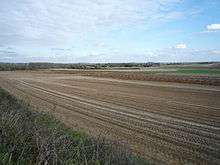Seine–Nord Europe Canal
| Seine – Nord Europe Canal | |
|---|---|
|
Location of the Seine-Nord Europe Canal in northern France. | |
| Specifications | |
| Length | 105 km (65 mi) |
| Lock length | 195 m (640 ft) |
| Lock width | 12.5 m (41 ft) |
| Maximum boat length | 185 m (607 ft) (x2 push-tug) |
| Maximum boat beam | 11.4 m (37 ft) |
| Minimum boat draft | 3 m (9.8 ft) |
| Original number of locks | 7 |
| Total rise | 139 m (456 ft) |
| Status | Preparation for tender |
| History | |
| Expected completion | 2025 [1] |
| Geography | |
| Start point | Oise River at Janville, Oise |
| End point | Canal Dunkerque-Escaut, east of Arleux |
The Seine–Nord Europe Canal is a project of a high capacity canal in France that would link the Oise River at Janville, Oise, and the Canal Dunkerque-Escaut, east of Arleux. The net effect would be to considerably expand trade flows in a fuel-efficient and ecologically friendly manner while connecting to surrounding northern European countries such as Belgium, Germany and the Netherlands.
The canal will be the French section of the Seine-Escaut (Scheldt) European link. It will run 106 km from Janville, north of Compiègne, to the Canal Dunkerque-Escaut, crossing the regions of Picardy and Nord-Pas-de-Calais.[2]
The 105-kilometre-long canal will connect the Seine and Scheldt rivers and facilitate the transport of goods through inland waterways. When the new Seine Nord connection is ready, it will allow large vessels to transport goods between the Seine river (and the Paris area) and the ports of Dunkerque, Antwerp, and Rotterdam, or further into Europe. The canal will replace the Canal de Saint-Quentin and the current Canal du Nord, increasing maximum barge capacity from 650 to 4400 tonnes.[3]
The canal will include several large structures, including seven locks and three aqueducts: two over the A29 and A26 autoroutes, and one 1330 metres long over the Somme.[4] The project’s budget will be €4.2 billion, financed by the European Union, the French government, local regional governments and through public-private partnerships.
The project was reported, in July 2012, to be seriously in doubt, [5] but significant cost reductions are deemed possible, and a decision was to be made in 2014.[6] Engineers were selected for the project in June 2015.[1]
On 21 April 2016, an ordonnance was approved by the President of France, authorizing the construction of the canal and creating the Société du Canal Seine-Nord Europe to manage the project.[7]
Environmental impact
According to Nicolas Bour, the project leader of the Seine-Nord Europe Mission, "1500 containers unloaded in a maritime port equal 1000 trucks on the road or 25 fully loaded goods trains, but only 5 vessels."

References
- 1 2 "107 kilometer kanaal verbindt Frans en Nederlands waternetwerk". Verkeerskunde (in Dutch). 25 June 2015.
- ↑ European Conference of Ministers of Transport, Organisation for Economic Co-operation and Development (2006). Inland waterways & environmental protection. OECD Publishing. p. 103. ISBN 978-92-821-1346-2.
- ↑ VNF, 'The canal Seine-Nord Europe project planning regional, national and European'
- ↑ VNF, Canal and related facilities
- ↑ Seine-Nord project in doubt
- ↑ http://uk.reuters.com/article/2013/12/11/france-canal-idUKL6N0JQ3O520131211?feedType=RSS&feedName=rbssFinancialServicesAndRealEstateNews
- ↑ "Ordonnance n° 2016-489 du 21 avril 2016 relative à la Société du Canal Seine-Nord Europe (NOR: DEVT1605203R)". Legifrance. 21 April 2016.
External links
- Official project website
- VNF presentation slides
- French waterways context french-waterways.com
